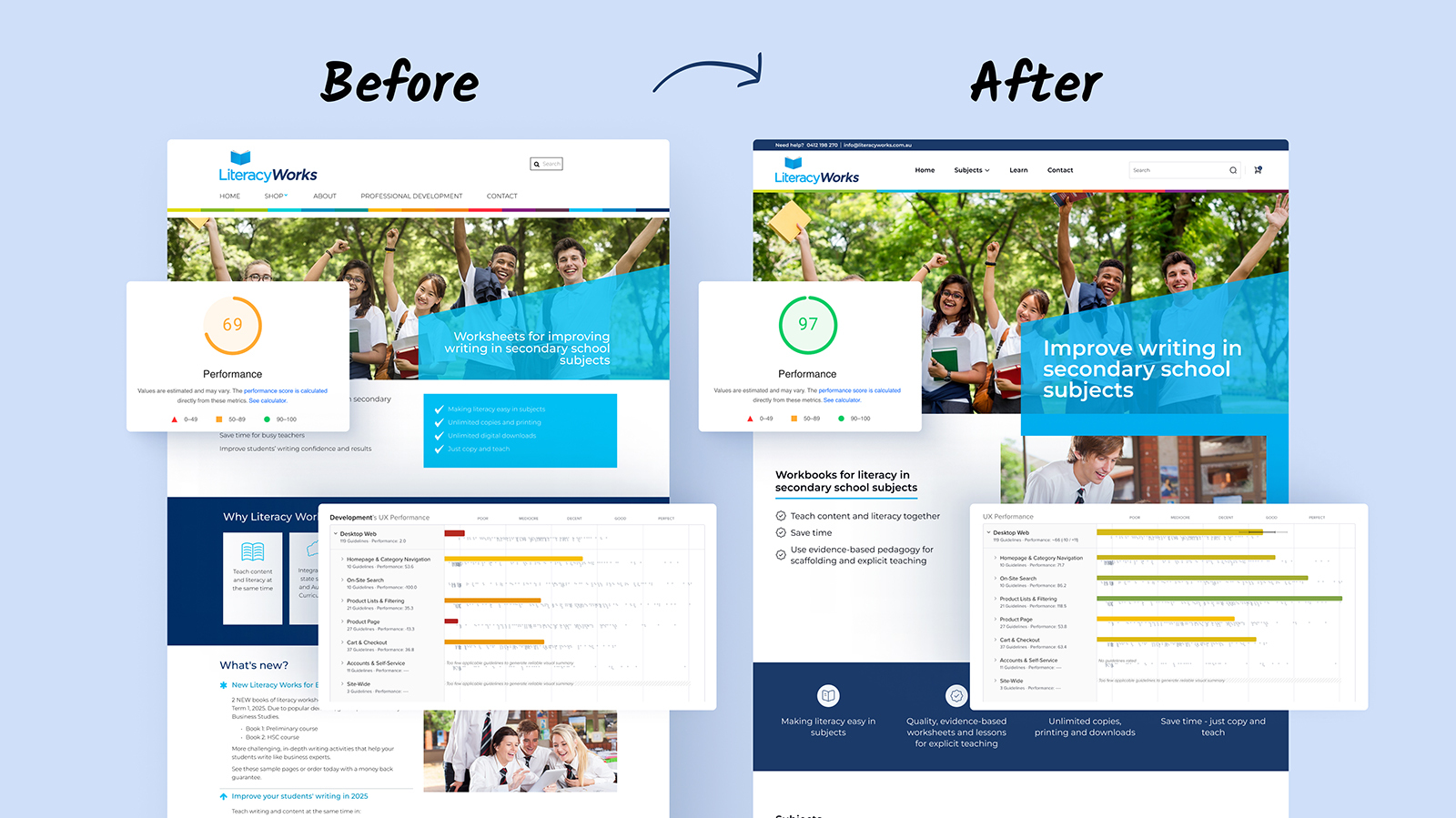260% revenue growth. Sub-800ms page loads. Zero platform migration.
After 4 years of incremental fixes, Trish Weeks knew her WooCommerce store needed more than another band-aid. LiteracyWorks sells workplace literacy training materials – instant downloads and physical workbooks – to Australian businesses and government agencies. But the site was hemorrhaging users with 4.2 second load times and invisible in search with 46/100 SEO ratings.
This article is part of our WooCommerce Performance Optimization series. For the complete guide covering why stores are slow and how to fix it, start there.
Most agencies would have pitched a complete platform migration. New hosting. New architecture. Six-figure investment. Six-month timeline.
We delivered enterprise-level performance in 3 weeks using native WordPress and WooCommerce. Here’s how.
The Performance Problem Killing WooCommerce Stores
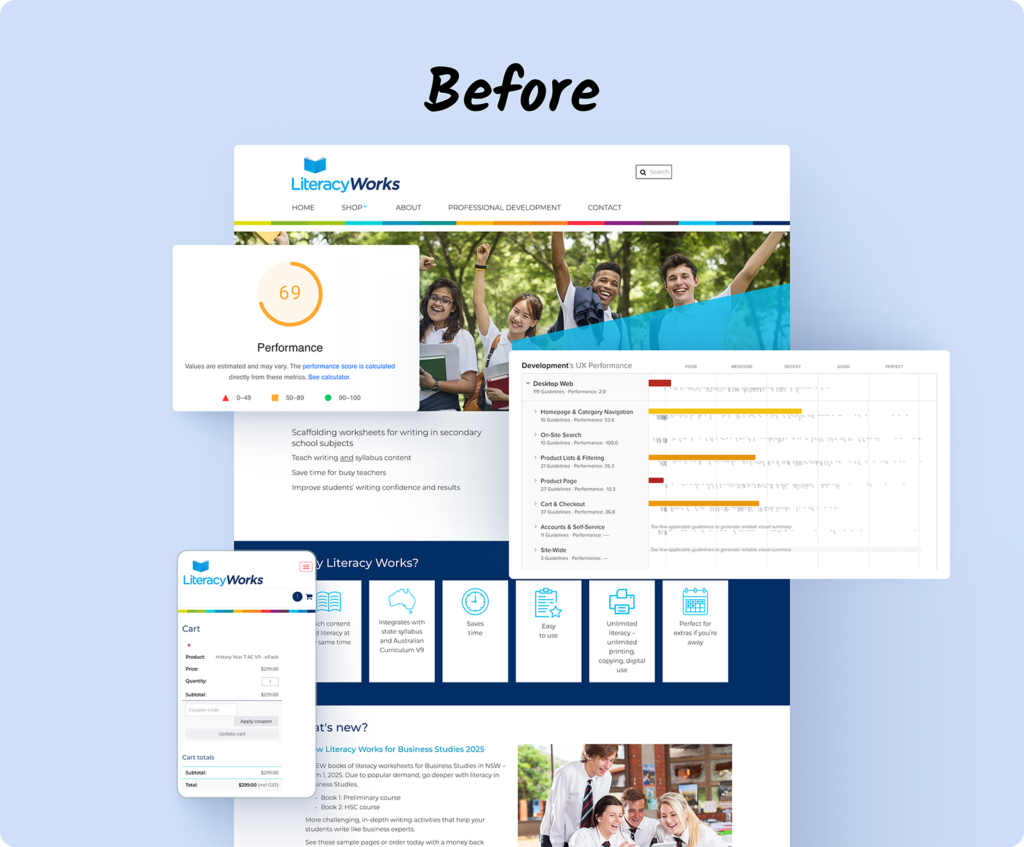
WordPress and WooCommerce power 40% of the web. They also carry 20 years of technical debt. Default installations load jQuery on every page, run dozens of database queries for simple operations, and ship megabytes of unused CSS and JavaScript.
LiteracyWorks exhibited every symptom:
- 4.2 second First Contentful Paint
- 69/100 Mobile performance score
- 46/100 SEO score
- 3.2MB page weight for a simple product page
- 47 plugins running (most unused but still loading)
The standard solutions most agencies propose:
- Expensive hosting upgrades (marginal improvement)
- Caching plugins (band-aid on structural problems)
- Platform migration (massive cost and risk)
- Rebuilding on headless architecture (significant investment)
After 10 years optimizing WooCommerce stores, we’ve developed a different approach.
The Blaze Commerce Method: Performance Without Migration
Year 1-4: Keeping the Lights On
We’d worked with Trish since 2020, handling WordPress updates, security patches, and minor fixes. The relationship gave us deep knowledge of her business: government contracts requiring instant invoice generation, training materials needing immediate download access, and physical workbooks shipping to remote mining sites.
View more of our client success stories →
Year 5: The Breaking Point
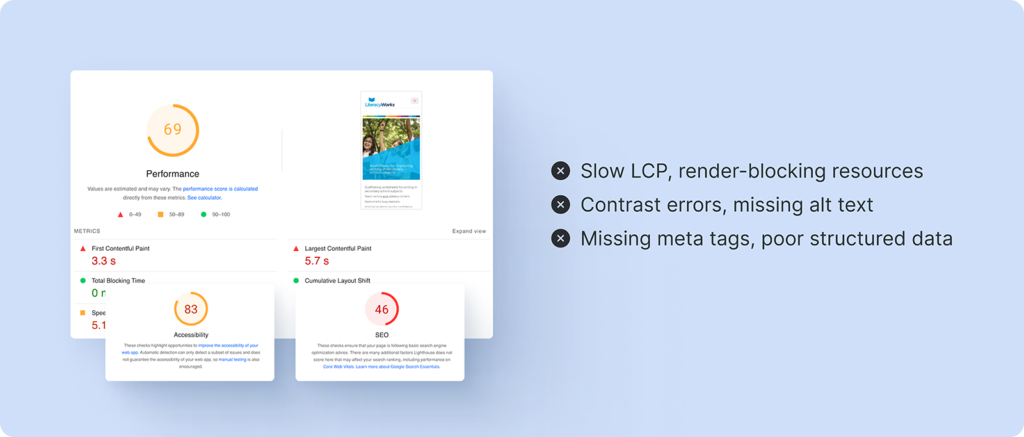
A government procurement officer mentioned the site “felt outdated” during a contract review. Competitors with inferior training programs were winning contracts because their sites loaded faster. Trish had three options:
- Template refresh: Cosmetic change only, minimal performance impact
- Basic optimization: Band-aid fixes, marginal improvement
- Complete Performance Woo rebuild: Enterprise performance, complete architectural overhaul
She chose option 3.
The Technical Execution
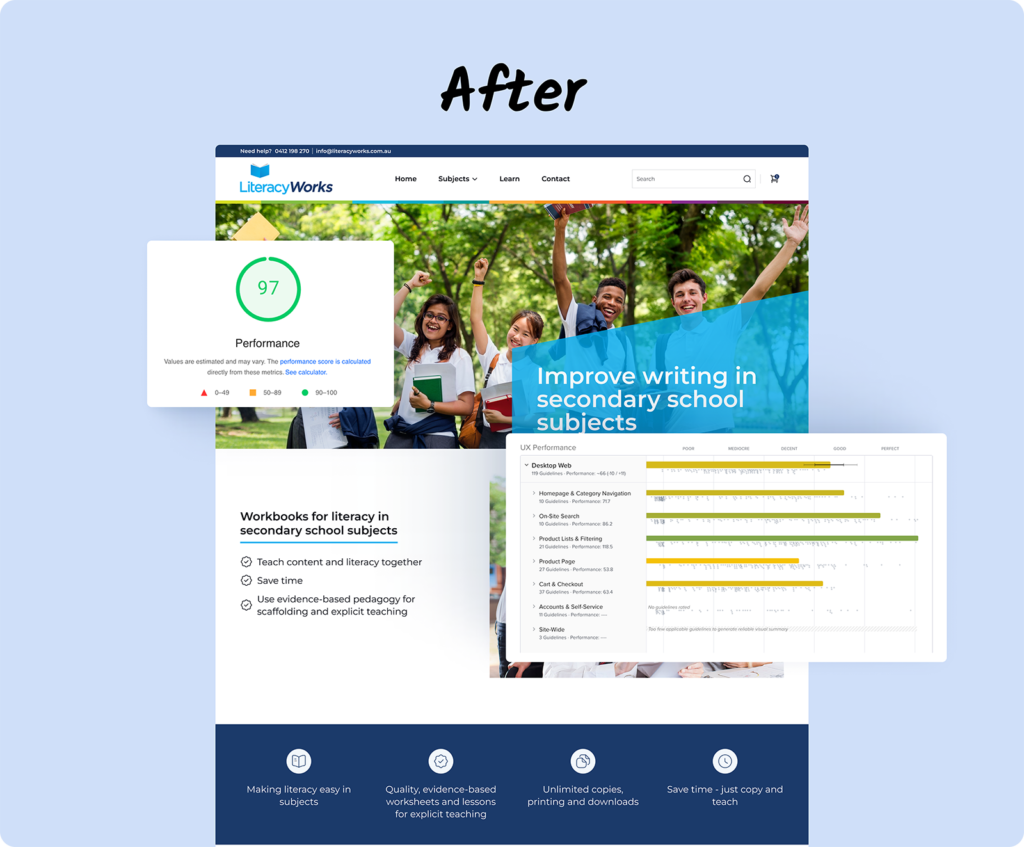
Phase 1: Gutenberg Migration
Stripped the 5-year-old page builder that was injecting 1.2MB of unused code. Rebuilt everything using native Gutenberg blocks. No third-party dependencies. Just clean, semantic HTML.
Phase 2: Database Optimization
- Removed 47 unused plugins (each adding 5-10 database queries)
- Optimized WooCommerce session handling
- Implemented object caching for product queries
- Cleaned 5 years of database bloat
Result: 78% reduction in Time to First Byte.
Phase 3: Asset Optimization
- Converted 400+ images to WebP format (60% smaller)
- Implemented native lazy loading
- Removed jQuery dependencies where possible
- Selective script loading (WooCommerce JS only on shop pages)
Result: Page weight dropped from 3.2MB to 680KB.
Phase 4: Caching Architecture
- LiteSpeed Cache at server level
- Perfmatters removing unused scripts per page
- CDN implementation with proper cache headers
- Critical CSS inlining
Result: 0.8 second page loads for returning visitors.
Phase 5: WooCommerce-Specific Optimizations
- Streamlined order processing for digital downloads
- Deferred cart fragment loading
- Optimized checkout field validation
- AJAX add-to-cart without page reload
The Results: Enterprise Performance, WordPress Simplicity

Technical Metrics
| Metric | Before (Mobile) | After (Mobile) | Improvement |
| Performance | 69/100 🟠 | 97/100 🟢 | +28 (Mobile) |
| Accessibility | 83/100 🟠 | 100/100 🟢 | +17 to +25 |
| Best Practices | 96/100 🟢 | 93/100 🟢 | Minor variation |
| SEO | 46/100 🔴 | 100/100 🟢 | +54 (Massive!) |
Business Impact
- Revenue: +260% year-over-year
- Net Sales: +232% increase
- Session Duration: +340% improvement
- Support Tickets: -100% for download issues
The fascinating part: order volume only increased 27% but revenue jumped 260%. Better performance attracted enterprise clients placing larger orders.
Why This Approach Works
After 10 years optimizing WooCommerce stores, we’ve learned:
- The best solution maintains business continuity. Trish still updates content herself. Her custom invoice system still works. Her fulfillment process didn’t change. Just everything runs 5x faster.
- Most performance issues are architectural, not platform-based. WordPress and WooCommerce can be fast. They’re just not fast by default.
- Migrations are expensive and risky. Moving platforms means retraining staff, rebuilding integrations, and hoping nothing breaks.
- You don’t need bleeding-edge tech for world-class performance. Sub-800ms loads are achievable with proper optimization of native WordPress.
Who This Works For
Performance Woo is ideal for:
- WooCommerce stores doing $20k-$2M monthly revenue
- Businesses wanting enterprise speed without enterprise complexity
- Stores with custom functionality worth preserving
- Owners who update their own content
- Companies selling digital products, physical goods, or both
It’s not for:
- Stores needing multiple frontend applications
- Businesses with dedicated development teams
- Stores already achieving sub-1-second loads
The Investment Reality
Typical “Solutions” and Their Problems:
- Premium Hosting: Monthly recurring costs with minimal improvement
- Basic Speed Optimization: Temporary band-aids that degrade over time
- Platform Migration: Massive disruption to your business operations
- Custom Development: Complex solutions requiring ongoing technical support
Performance Woo: Our clients typically see complete return on investment within 3-4 months based on increased sales from performance and UX improvements. 2-3 week timeline. No platform change. No business disruption.
For LiteracyWorks, the 260% revenue increase paid for the investment in the first month.
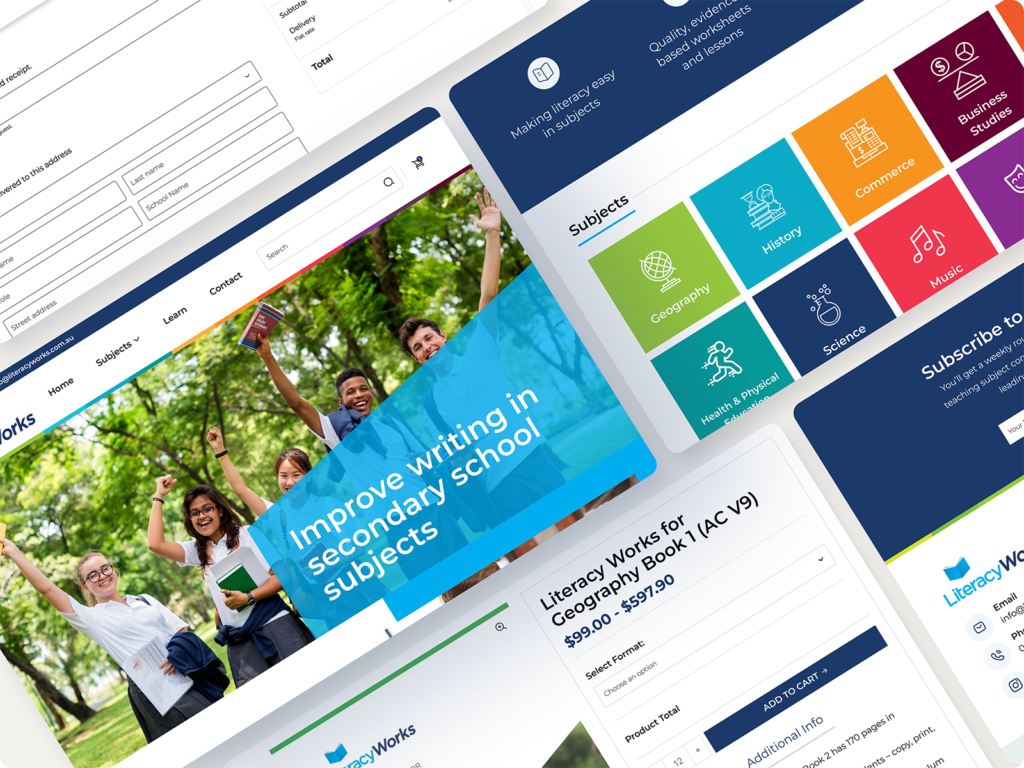
Common Questions
“Will my existing plugins still work?”
We audit everything. Most sites have 20+ unnecessary plugins slowing them down. We keep what provides value, replace what doesn’t, optimize what remains.
“What about my custom functionality?”
We preserve all business logic. LiteracyWorks kept their instant download system, government invoice generation, and bulk order processing.
“How long do these improvements last?”
Unlike band-aid solutions, architectural improvements are permanent. Sites stay fast with basic maintenance.
“Can’t I just install caching plugins?”
Caching helps but doesn’t fix underlying problems. It’s like putting premium fuel in a broken engine.
“Should I get a UX audit first?”
Our ecommerce UX audit service can identify conversion killers before rebuilding. For LiteracyWorks, we addressed UX issues during the Performance Woo rebuild.
The Path Forward
Two options for WooCommerce store owners:
Get Access to our Performance Audit. We analyze your specific bottlenecks and show exactly what’s slowing your store. Includes Core Web Vitals analysis, plugin audit, and prioritized recommendations.
Schedule Demo to see real client sites achieving sub-1-second loads on native WooCommerce. 30-minute screen share. No pitch unless you ask.
LiteracyWorks has worked with Blaze Commerce since 2020. Performance improvements measured via Google PageSpeed Insights and GTmetrix. Revenue data from Google Analytics year-over-year comparison. Explore their workplace literacy training resources →
